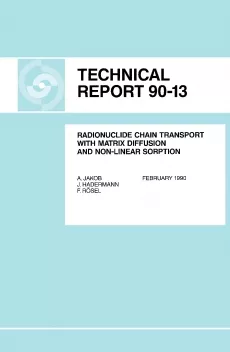
Technical Report NTB 90-13
Radionuclide chain transport with matrix diffusion and non-linear sorption
The present paper describes a two-dimensional model for radionuclide chain transport in inhomogeneous rock.
Advective and dispersive flux takes place in water conducting zones which may consist of a network either of tubelike veins or planar fractures. Out of these flowpaths nuclides diffuse into stagnant pore water of a spatially limited, adjacent zone (matrix diffusion). Sorption on rock surfaces is described by a non-linear isotherm. Under specific conditions matrix diffusion can be represented by an effective (non-linear) surface sorption. Radioactive decay and, in the case of a nuclide chain, ingrowth is also included in the model.
The numerical solutions of transport equations based on the method of lines are developed in detail. The advantages of this approach are the efficiency, the reliability and the general flexibility especially to include arbitrary boundary and initial conditions and arbitrary solute/rock interactions.
For 135Cs we present in a comprehensive sensitivity analysis the impact of non-linear (Freundlich) sorption isotherm on break-through curves. It is shown that, provided transport times are comparable or larger than nuclide half-life, non-linear sorption may reduce concentrations at the geosphere outlet by orders of magnitude. Some results are also given for the transport of the 238U chain.
